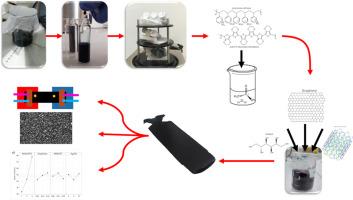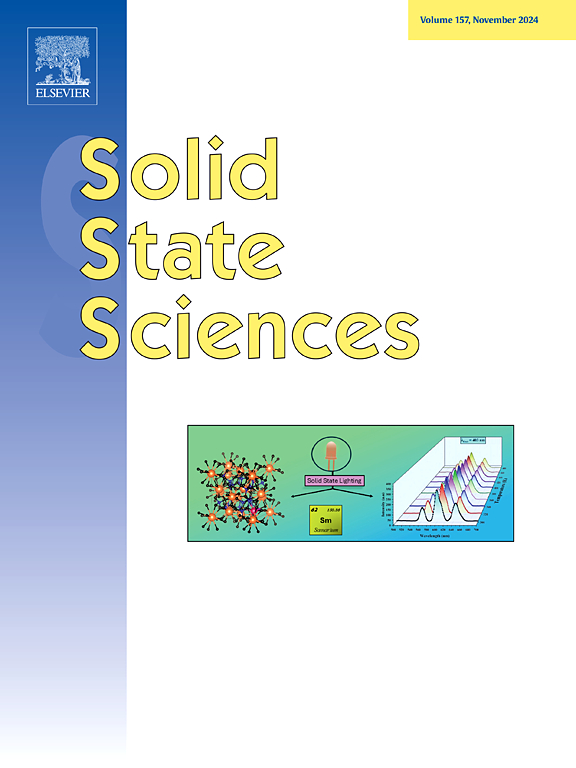Development of graphene/MWCNT/Ag2Se hybrid thermoelectric materials with different concentrations of PEDOT:PSS for low-temperature applications
IF 3.3
3区 化学
Q2 CHEMISTRY, INORGANIC & NUCLEAR
引用次数: 0
Abstract
Studies in low-temperature applications in the fields of medicine and wearable technologies are limited to thermoelectric works with commercial poly(3,4-ethylenedioxy-thiophene):polystyrenesulfonate (PEDOT:PSS) aqueous solutions. Unlike other studies, in this study, the effects of adding graphene, multi-walled carbon nanotube (MWCNT) and silver selenide into PEDOT:PSS at different concentrations in the production of semiconductor polymer inks on the thermoelectric properties were examined using Taguchi analysis. In the examination without adding additives, as the ratio of PEDOT:PSS increased from 1 % to 3 % and 5 %, 2.50 and 4.92 times increase in electrical conductivity and 1.19 and 1.49 times increase in the Seebeck coefficient were observed, respectively. P- and n-type inks were produced in three different concentrations using four different materials. According to the results of the study, to obtain p-type material with good performance, the concentration of PEDOT:PSS in the mixture must be high and the Ag2Se concentration must be low, and also to get a high-performance n-type material, the concentration of Ag2Se must be as high as the homogeneous mixture allows, and PEDOT:PSS concentration must be low. When the highest Power Factor and Figure of Merit results were evaluated, PPp9 was found for p-type material and PPn2 was found for n-type material, and it is considered that these inks are suitable for printing with 3D printing technology.

开发具有不同浓度 PEDOT:PSS 的石墨烯/MWCNT/Ag2Se 混合热电材料,用于低温应用
医学和可穿戴技术领域的低温应用研究仅限于使用商用聚(3,4-乙二氧基噻吩):聚苯乙烯磺酸盐(PEDOT:PSS)水溶液进行热电工作。与其他研究不同的是,本研究采用田口分析法考察了在生产半导体聚合物油墨时向 PEDOT:PSS 中添加不同浓度的石墨烯、多壁碳纳米管(MWCNT)和硒化银对热电性能的影响。在不添加添加剂的情况下,随着 PEDOT:PSS 的比例从 1 % 增加到 3 % 和 5 %,电导率分别增加了 2.50 倍和 4.92 倍,塞贝克系数分别增加了 1.19 倍和 1.49 倍。使用四种不同的材料生产了三种不同浓度的 P 型和 n 型油墨。研究结果表明,要获得性能良好的 p 型材料,混合物中 PEDOT:PSS 的浓度必须高,Ag2Se 的浓度必须低;要获得高性能的 n 型材料,Ag2Se 的浓度必须在均匀混合物允许的范围内尽可能高,PEDOT:PSS 的浓度必须低。在评估最高功率因数和优越性结果时,发现 p 型材料的功率因数为 PPp9,n 型材料的功率因数为 PPn2,因此认为这些油墨适合使用 3D 打印技术进行打印。
本文章由计算机程序翻译,如有差异,请以英文原文为准。
求助全文
约1分钟内获得全文
求助全文
来源期刊

Solid State Sciences
化学-无机化学与核化学
CiteScore
6.60
自引率
2.90%
发文量
214
审稿时长
27 days
期刊介绍:
Solid State Sciences is the journal for researchers from the broad solid state chemistry and physics community. It publishes key articles on all aspects of solid state synthesis, structure-property relationships, theory and functionalities, in relation with experiments.
Key topics for stand-alone papers and special issues:
-Novel ways of synthesis, inorganic functional materials, including porous and glassy materials, hybrid organic-inorganic compounds and nanomaterials
-Physical properties, emphasizing but not limited to the electrical, magnetical and optical features
-Materials related to information technology and energy and environmental sciences.
The journal publishes feature articles from experts in the field upon invitation.
Solid State Sciences - your gateway to energy-related materials.
 求助内容:
求助内容: 应助结果提醒方式:
应助结果提醒方式:


